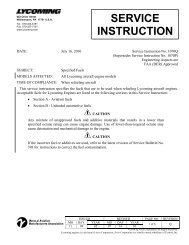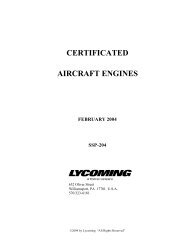You also want an ePaper? Increase the reach of your titles
YUMPU automatically turns print PDFs into web optimized ePapers that Google loves.
per hour. Since work is force exerted through a given distance,<br />
it is measured in terms of feet pounds. Thus, on an average, one<br />
horse could do work at the rate of 33,000 feet pounds per minute<br />
or 550 feet pounds per second.<br />
Watt’s definition for one horsepower, which has now become<br />
universal, was, therefore, the doing of work at the rate of 33,000<br />
feet pounds per minute. Today, all conventional power producing<br />
units are rated on this basis.<br />
The 250-horsepower engine in the modern light plane is capable<br />
of doing work at the same rate as that of 250 average horses. From<br />
an interested engineer’s point of view, it is capable of moving<br />
137,500 pounds of weight one foot in one second. Yet, what a difference<br />
there is in its size and weight (approximately 400 pounds)<br />
when compared to the horses it replaces!<br />
CUTAWAY OF A FOUR CYLINDER POWER PLAN<br />
L y c o m i n g F l y e r<br />
The effect the propeller has on engine operation and on aircraft<br />
performance is quite significant. Based on questions which have<br />
been asked by aircraft owners and from experience, there are<br />
several areas of propeller-related information which may be<br />
of interest.<br />
Aircraft equipped with a fixed-pitch propeller will usually have<br />
static RPM (full throttle with aircraft standing still) limitations<br />
and full power in-flight RPM limitations spelled out in the Pilot’s<br />
Operating Handbook. If static RPM is below the minimum specified,<br />
the engine could be low in power. However, experience has<br />
shown that this is not always true. Faulty induction air systems<br />
and/or faulty exhaust systems have been shown to contribute to<br />
indications of low power. A propeller which is ever so slightly<br />
less than perfect may cause the static RPM to be outside the designated<br />
full throttle static RPM zone. In addition to these other<br />
factors, it is not unusual to find a tachometer which is inaccurate.<br />
If an incorrect static RPM reading is observed during the engine<br />
check, any one or all of these components could be at fault.<br />
The tachometer may be the easiest to check as there are hand-held<br />
devices that quickly give an RPM reading that will verify the<br />
accuracy of the standard aircraft instrument. Knowing the accuracy<br />
limits of the aircraft tachometer may eliminate the need for<br />
further examination of the engine and propeller, or it may confirm<br />
the need for further troubleshooting. In any case, consider each<br />
component of the system before blaming low-static RPM reading<br />
on one of them.<br />
Another aspect of operation with a fixed-pitch propeller came in<br />
the form of a question from a <strong>Lycoming</strong> engine owner. He indicated<br />
that the propeller provided by the airframe manufacturer<br />
had been exchanged for a cruise propeller. (This exchange should<br />
only be done with FAA approval.) With the new cruise propeller in<br />
use, an increase in fuel usage was soon apparent. Operating costs<br />
increased, and an explanation was requested.<br />
It is well known that the amount of horsepower taken from an<br />
engine will have a direct relationship to the amount of fuel used.<br />
Therefore, it can be deduced that use of the cruise propeller<br />
increased the horsepower requirement. This deduction deserves<br />
some additional explanation.<br />
As an example, the standard propeller supplied with an aircraft<br />
may allow the engine to develop 180 horsepower at 2700 RPM at<br />
full throttle, in flight at sea level, with a standard temperature. The<br />
<strong>Lycoming</strong> O-360-A Series normally aspirated engine illustrates<br />
this example.<br />
Next, let us assume that this same engine/propeller combination<br />
is operated at 75% power with a “best economy”<br />
fuel/air mixture setting. Again, assume sea level and standard<br />
temperature to simplify and standardize the discussion.<br />
75% power will require about 2450 RPM with a brake-specific<br />
fuel consumption of .435 pounds per brake horsepower<br />
hour. Also, 75% of the 180 rated horsepower is equal to<br />
135 horsepower. Fuel usage at this power and mixture setting<br />
will be 58.7 pounds per hour or 9.8 gallons per hour.







